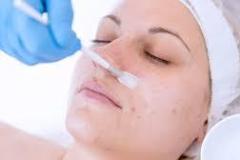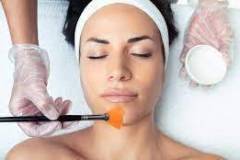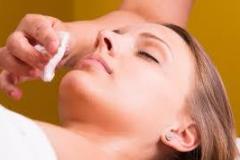| Time (in minutes) | Amount |
|---|---|
| 60 | $90 |
What is it
Chemical peels (AHA or Salicylic Acid) are cosmetic treatments that use a chemical solution to remove the outer layer of damaged skin, revealing smoother, brighter, and healthier-looking skin. Chemical peels are be used to treat a variety of skin concerns, including fine lines and wrinkles, acne scars, hyperpigmentation, and sun damage.
During a chemical peel treatment, a chemical solution is applied to the skin, which causes the top layer of the skin to slough off, revealing new skin cells underneath. The depth and intensity of the peel can be adjusted based on the patient’s skin type and the severity of their skin concerns.
Commonly Asked Questions
Who should get it?
People who may benefit from chemical peels include those who:
- Have fine lines and wrinkles
- Have uneven skin tone or texture
- Have acne or acne scars
- Have sun-damaged skin
- Have hyperpigmentation or age spots
- Want to improve the overall appearance and health of their skin
Chemical peels are generally safe and effective when performed by a licensed healthcare professional with experience in the procedure. It’s important to consult with a healthcare professional to determine if a chemical peel is a suitable treatment for your skin type and condition.
Who shoudnt get it?
People who may not be good candidates for chemical peels include those who:
- Have active skin infections, such as cold sores or herpes
- Have a history of abnormal scarring or keloids
- Have recently undergone radiation therapy
- Are pregnant or breastfeeding
- Have taken isotretinoin (Accutane) within the past 6 months
- Have very sensitive skin
- Have recently had a facial waxing or used depilatory creams
It’s important to consult with our licensed aestheticians to see if it is suitable for you We can evaluate your skin type, medical history, and any other factors that may affect the safety and effectiveness of the treatment. They can also help you choose the right type of chemical peel based on your skin concerns and goals.
What are the benefits?
Chemical peels offer a number of benefits for improving the appearance and health of the skin. Some of the main benefits of chemical peels include:
- Improving skin texture smooths out rough skin texture and promote a more even and refined skin surface.
- Reducing fine lines and wrinkles: stimulates collagen production, which can help to reduce the appearance of fine lines and wrinkles.
- Treating acne and acne scars: helps to unclog pores and reduce the severity of acne breakouts. They can also help to fade acne scars and hyperpigmentation.
- Reducing hyperpigmentation and sun damage: helps to fade dark spots and discoloration caused by sun exposure and other environmental factors.
- Enhancing skin radiance: helps to brighten dull, tired-looking skin and promote a more youthful, radiant complexion.
- Minimizing pores: helps to reduce the appearance of enlarged pores by removing dead skin cells and promoting skin renewal.
- Improving overall skin health: helps to promote healthy skin regeneration and improve the overall health and appearance of the skin.
What to expect after?
After a chemical peel treatment, it’s normal to experience some temporary side effects as the skin heals and regenerates. The intensity and duration of the side effects can vary depending on the depth of the peel and your skin type.
Here are some common side effects and what to expect after a chemical peel:
- Redness: It’s normal to experience some redness immediately after the peel, which can last for a few days to a week, depending on the depth of the peel.
- Peeling: The treated area may start to peel and flake within a few days after the peel. This is a normal part of the healing process and can last for several days to a week.
- Dryness: Your skin may feel dry and tight after the peel. It’s important to keep your skin moisturized with a gentle, non-comedogenic moisturizer to help prevent excessive dryness.
- Sensitivity: Your skin may be more sensitive to sun exposure after the peel, so it’s important to wear sunscreen with a high SPF and avoid prolonged sun exposure.
- Discomfort: Some people may experience mild discomfort or stinging during the peel, which should subside shortly after the treatment
Chemical peels can be performed on various parts of the body, including the face, neck, chest, and hands. The treatment can cause some temporary side effects, such as redness, flaking, and peeling of the skin, but these usually subside within a few days to a week.
Instructions
Pre-Care Instructions
1. Avoid Sun Exposure: Minimize sun exposure and use sunscreen regularly in the weeks leading up to your treatment. Sunburned or tanned skin should not undergo peels.
2. Skincare Products: Discontinue the use of retinoids, acids, exfoliating products, and other harsh skincare ingredients for at least one week before your chemical peel session, as they can increase skin sensitivity.
3. Skin Infections or Breakouts: If you have active cold sores, or significant breakouts, it is advisable to postpone the peel until the skin has healed to avoid spreading or worsening the condition.
4. Avoid Shaving and Waxing: If you typically shave or wax your face, it’s important to stop these activities a few days before a chemical peel to ensure the skin is not irritated or compromised.
Post-Care Instructions
1. Avoid Sun Exposure: After, the skin may be more susceptible to sun damage. Apply a broad-spectrum sunscreen with at least SPF 30 and limit sun exposure for a few days following the procedure.
2. Gentle Cleansing: Use a gentle cleanser to cleanse the face. Avoid using harsh scrubs or masks that may irritate the skin.
3. Moisturize: Apply a hydrating moisturizer to soothe and nourish the skin or cool aloe vera gel.
4. Avoid Makeup: It is recommended to avoid wearing heavy makeup for the first 24-48 hours after a peel to allow the skin to breathe.
5. Avoid Irritating Products: Refrain from using harsh skincare products such as exfoliants, retinoids, acids, or alcohol-based toners for a few days after, as they can cause further irritation.
6. Sun Protection: Even after the initial post-care period, continue to protect your skin from the sun by using sunscreen daily.
7. Follow-up Treatments: Depending on your skin concerns, a series of sessions may be recommended. Follow the recommended treatment plan and spacing intervals for optimal results.





